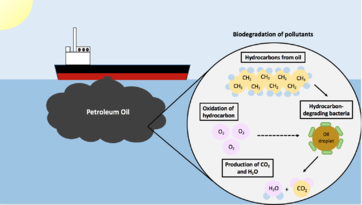
BIOREMEDIATION MECHANISM FOR OIL SPILLS
WHY IN NEWS?
- The National Institute of Ocean Technology (NIOT), Chnnai has developed an eco-friendly crude oil bioremediation mechanism technology using consortia (group of two or more species) of marine microbes wheat bran (WB) immobilized (microbes controlled degradation) on agro-residue bacterial cells.
- Wheat bran is the hard outer layer of the wheat kernel. It’s stripped away during the milling process.
- Bioremediation: It can be defined as any process that uses microorganisms or their enzymes to remove and or neutralize contaminants within the environment to their original condition.
Eco-friendly Crude Oil Bioremediation Mechanism Technology
- In the marine ecosystem, deep sea hydrocarbonoclastic (ability to degrade hydrocarbon) microbial consortium plays an important role in breaking down oil in the event of a spill.
- The microbial community serves as energetic primary degraders of a complex mixture of petroleum hydrocarbons into various aldehydes, ketones and acidic metabolites.
- These hydrocarbon degrading bacteria don’t depend on hydrocarbons for survival, but have a metabolic mechanism where they use petroleum products as carbon and energy source and thus, help cleaning up oil spills.
- The complete breakdown and degradation of crude oil is achievable using wheat bran marine bacterial consortia (which are low-cost non-toxic agro-residues) in an environmentally sustainable manner.
Advantages of Immobilized State:
- They are more effective in their immobilised state than the free bacteria cells in degrading the oil spills.
- They could remove 84% of the oils within 10 days. The free bacterial cells degraded a maximum of 60% of the crude oil at optimised conditions.
- They are more versatile and resistant to adverse conditions.
- They have efficacy in treating accidental bulk discharge of oil in marine environments through non-toxic clean-up technology.
OIL SPILL:
- It is an accidental/uncontrolled release of crude oil, gasoline, fuels, or other oil by-products into the environment. Oil spills can pollute land, air, or water, though it is mostly used for oceanic oil spills.
- The recent MV Wakashio spill off Mauritius — about 1,000 tonnes of oil spilled into a sanctuary for rare wildlife after the Japanese ship struck a coral reef in 2020.
- Containment Booms: Floating barriers, called booms are used to restrict the spread of oil and to allow for its recovery, removal, or dispersal.
- Skimmers: They are devices used for physically separating spilled oil from the water’s surface.
- Sorbents: Various sorbents (e.g., straw, volcanic ash, and shavings of polyester-derived plastic) that absorb the oil from the water are used.
- Dispersing agents: These are chemicals that contain surfactants, or compounds that act to break liquid substances such as oil into small droplets. They accelerate its natural dispersion into the sea.
